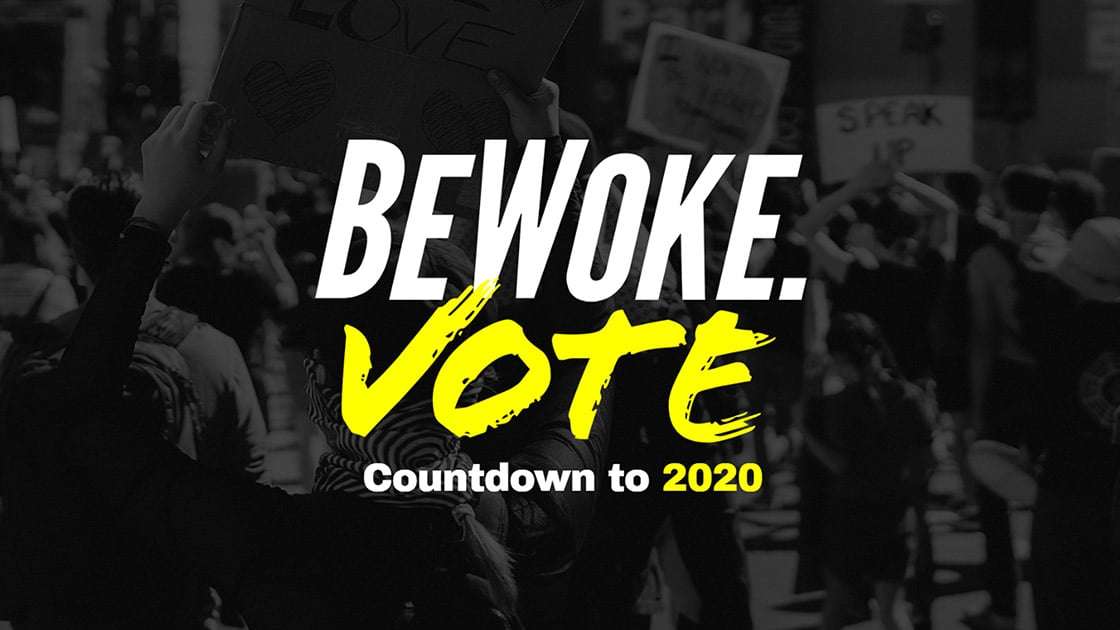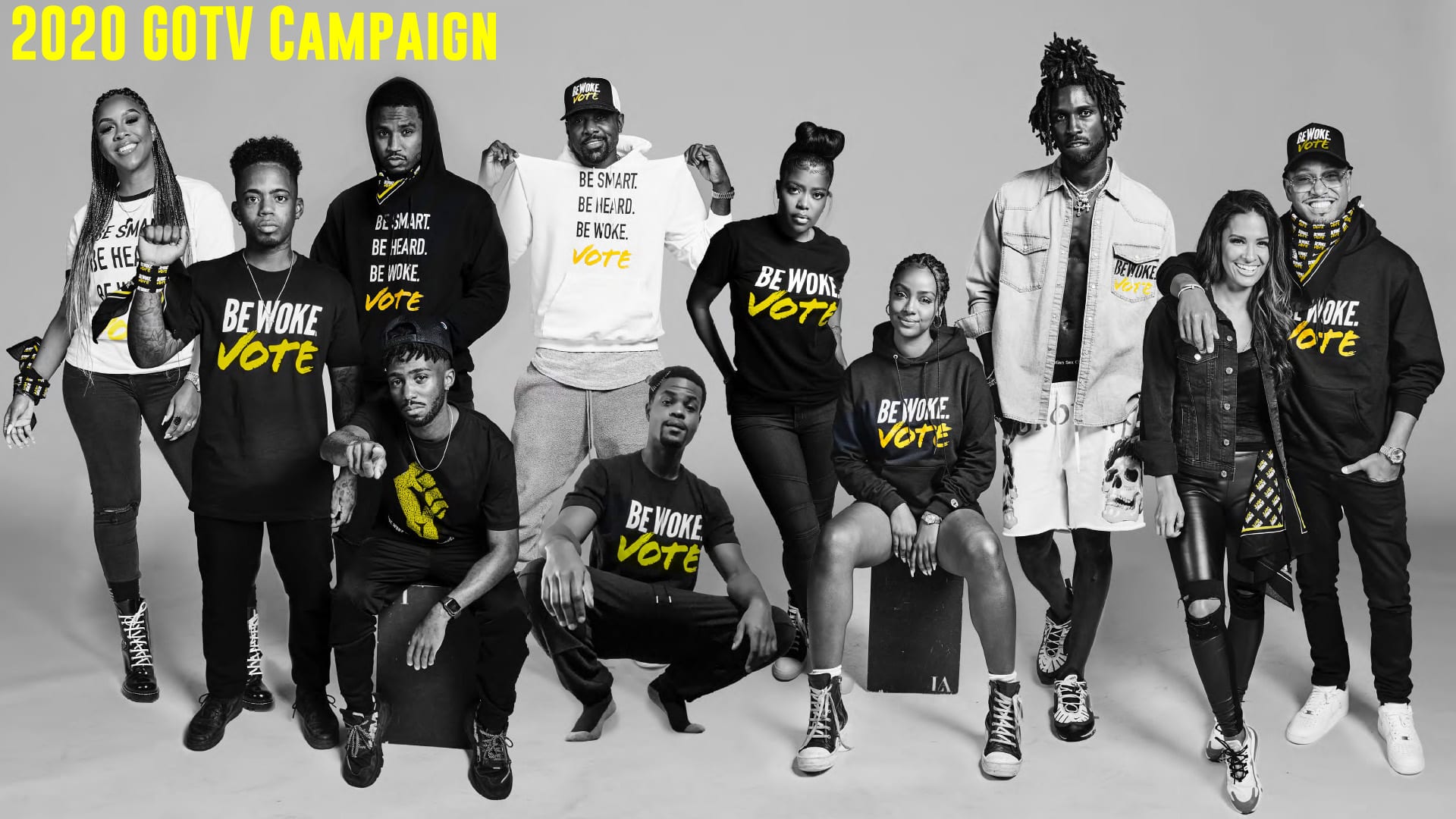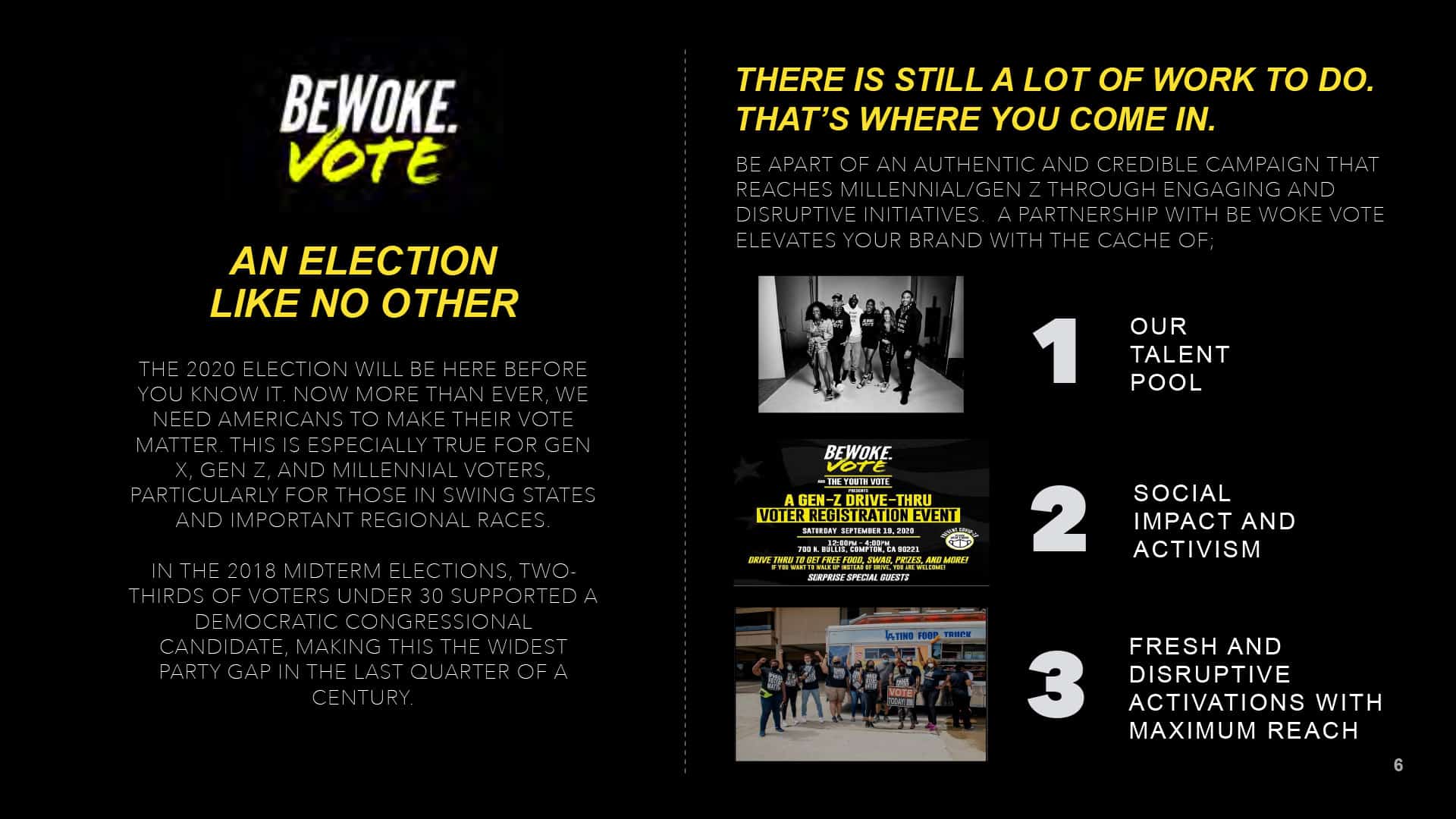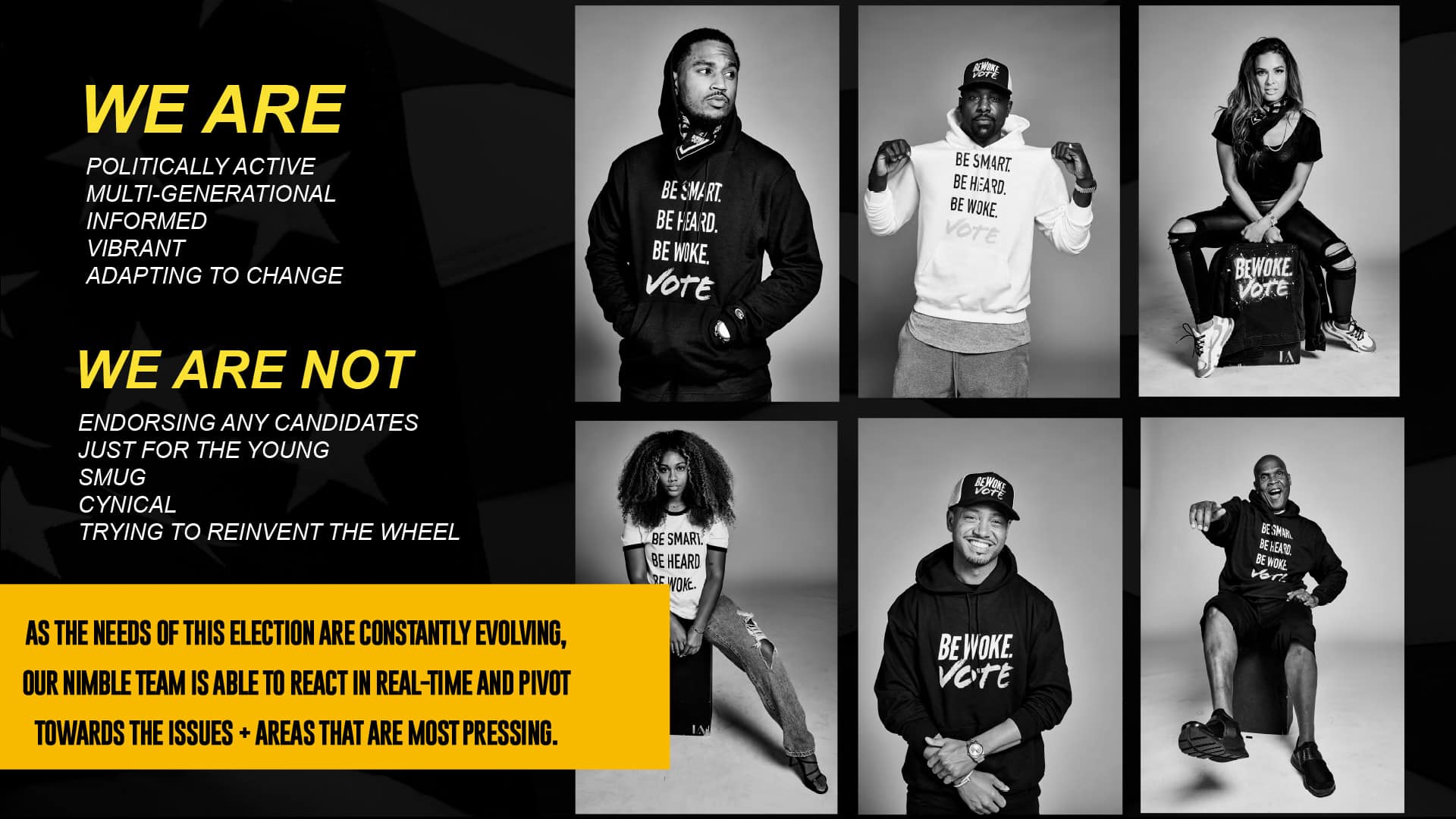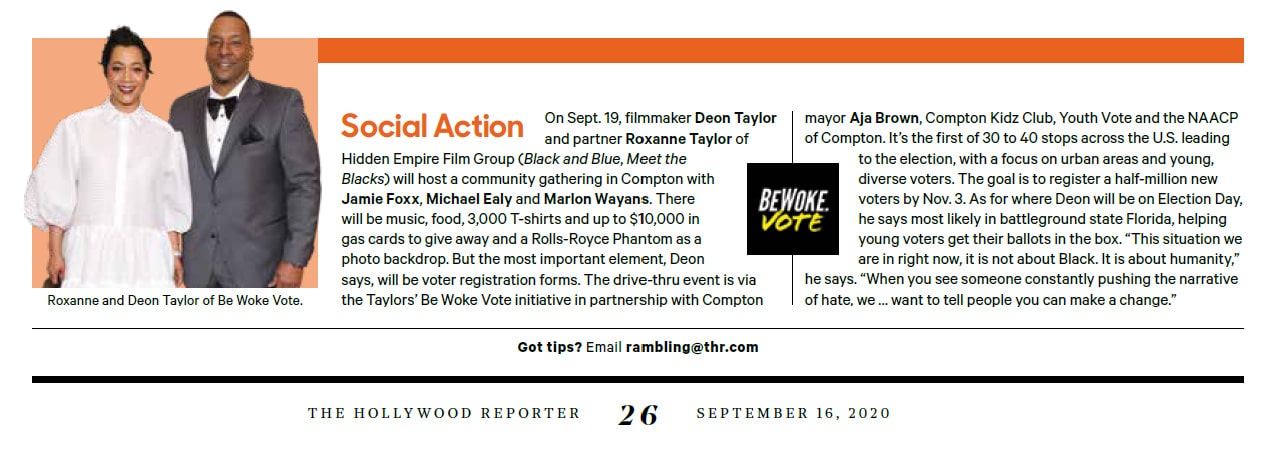Be Woke.Vote Campaign: 2020 Success
Unpacking the success of Be Woke.Vote 2020: How strategic digital engagement led to increased voter turnout.
Website Design: https://bwv.aone.la
Introduction
- Origins: Launched by visionaries including Robert F. Smith, Deon Taylor, Roxanne Avent, Darrick Angelone.
- Mission: To educate and engage a diverse young electorate, focusing on Gen Z and Millennials, in the political process.
- Overview of the Campaign: The "Be Woke.Vote" campaign in 2020 was designed to foster political engagement and voter participation, focusing on young and underrepresented communities. It utilized a multifaceted approach combining digital media, creative content, and grassroots initiatives.
- Purpose of the Case Study: This study aims to dissect the campaign's strategic planning and execution. Special attention is given to Aone's innovative contributions and the overarching success of the campaign.
- Methodology: In-depth analysis of various campaign materials, including strategic plans, digital and social media analytics, creative content, and post-campaign performance data.
Background
- Contextual Setting: In a year marked by significant political and social upheaval, the campaign sought to combat voter apathy and misinformation. The political landscape of 2020 provided both challenges and opportunities for voter engagement.
- Aone’s Profile: Aone, a central figure in the campaign, brought unique expertise in digital strategy and content creation. Their approach was instrumental in tailoring the campaign to resonate with the target demographics.
Campaign Strategy
- Campaign Goals and Objectives: The primary aim was to increase voter registration and turnout among young voters and minorities. This included educating voters, combating misinformation, and making voting more accessible.
- Target Audience: The campaign strategically targeted Millennials and Generation Z, utilizing platforms and messaging that appealed specifically to these demographics.
- Key Messages and Themes: The campaign emphasized the significance of each vote and the collective impact of participating in the democratic process.
Execution
- Creative Development: Led by Aone, the team crafted compelling visuals and narratives that were both informative and emotionally engaging, bridging the gap between political advocacy and relatable content.
- Digital and Social Media Strategy: A robust presence on platforms like Instagram, Twitter, and Facebook was established, with a balanced mix of organic outreach and strategically placed advertisements.
- Partnerships and Collaborations: The campaign collaborated with various influencers and community organizations to broaden its reach and reinforce its messaging.
- Paid Media and Advertising: Targeted online advertising campaigns were used to effectively reach potential voters, especially in key demographic areas.
Performance Analysis
- Metrics and Analytics: There was a notable increase in key metrics such as engagement rates, website traffic, and voter registration numbers, indicating the campaign's effective reach and resonance.
- Audience Response: The campaign received overwhelmingly positive feedback across social media platforms, indicating successful engagement.
- Media Coverage and Publicity: The campaign gained significant media coverage, enhancing its credibility and expanding its reach beyond direct digital channels.
Aone’s Impact
- Leadership and Innovation: Aone’s leadership was crucial in adapting the campaign's strategies to the rapidly changing political landscape and audience engagement trends.
- Challenges and Solutions: Aone's approach to combating misinformation involved creating clear, factual content that was easily digestible and shareable.
- Creative Contributions: Aone's creative vision was a defining element of the campaign, setting a unique tone and style that distinguished it from typical political campaigns.
Lessons Learned
- Success Factors: The campaign's success can be attributed to its targeted approach, innovative digital strategies, and effective messaging that resonated with the audience.
- Areas for Improvement: Insights suggest that future campaigns could benefit from more localized and personalized engagement strategies.
- Insights for Future Campaigns: The campaign underscored the importance of adaptability, creative messaging, and leveraging digital platforms to engage younger demographics.
Conclusion
- Summary of Findings: The "Be Woke.Vote" campaign markedly increased political engagement among its target audience, largely attributed to Aone's innovative strategies and the campaign’s adept use of digital media.
- Final Thoughts: This case study presents the "Be Woke.Vote" campaign as an exemplary model of how digital media, combined with creative content and grassroots initiatives, can be effectively used to drive political engagement and voter participation.
Be Woke.Vote Campaign: 2020 Success
Unpacking the success of Be Woke.Vote 2020: How strategic digital engagement led to increased voter turnout.
Website Design: https://bwv.aone.la
Introduction
- Origins: Launched by visionaries including Robert F. Smith, Deon Taylor, Roxanne Avent, Darrick Angelone.
- Mission: To educate and engage a diverse young electorate, focusing on Gen Z and Millennials, in the political process.
- Overview of the Campaign: The "Be Woke.Vote" campaign in 2020 was designed to foster political engagement and voter participation, focusing on young and underrepresented communities. It utilized a multifaceted approach combining digital media, creative content, and grassroots initiatives.
- Purpose of the Case Study: This study aims to dissect the campaign's strategic planning and execution. Special attention is given to Aone's innovative contributions and the overarching success of the campaign.
- Methodology: In-depth analysis of various campaign materials, including strategic plans, digital and social media analytics, creative content, and post-campaign performance data.
Background
- Contextual Setting: In a year marked by significant political and social upheaval, the campaign sought to combat voter apathy and misinformation. The political landscape of 2020 provided both challenges and opportunities for voter engagement.
- Aone’s Profile: Aone, a central figure in the campaign, brought unique expertise in digital strategy and content creation. Their approach was instrumental in tailoring the campaign to resonate with the target demographics.
Campaign Strategy
- Campaign Goals and Objectives: The primary aim was to increase voter registration and turnout among young voters and minorities. This included educating voters, combating misinformation, and making voting more accessible.
- Target Audience: The campaign strategically targeted Millennials and Generation Z, utilizing platforms and messaging that appealed specifically to these demographics.
- Key Messages and Themes: The campaign emphasized the significance of each vote and the collective impact of participating in the democratic process.
Execution
- Creative Development: Led by Aone, the team crafted compelling visuals and narratives that were both informative and emotionally engaging, bridging the gap between political advocacy and relatable content.
- Digital and Social Media Strategy: A robust presence on platforms like Instagram, Twitter, and Facebook was established, with a balanced mix of organic outreach and strategically placed advertisements.
- Partnerships and Collaborations: The campaign collaborated with various influencers and community organizations to broaden its reach and reinforce its messaging.
- Paid Media and Advertising: Targeted online advertising campaigns were used to effectively reach potential voters, especially in key demographic areas.
Performance Analysis
- Metrics and Analytics: There was a notable increase in key metrics such as engagement rates, website traffic, and voter registration numbers, indicating the campaign's effective reach and resonance.
- Audience Response: The campaign received overwhelmingly positive feedback across social media platforms, indicating successful engagement.
- Media Coverage and Publicity: The campaign gained significant media coverage, enhancing its credibility and expanding its reach beyond direct digital channels.
Aone’s Impact
- Leadership and Innovation: Aone’s leadership was crucial in adapting the campaign's strategies to the rapidly changing political landscape and audience engagement trends.
- Challenges and Solutions: Aone's approach to combating misinformation involved creating clear, factual content that was easily digestible and shareable.
- Creative Contributions: Aone's creative vision was a defining element of the campaign, setting a unique tone and style that distinguished it from typical political campaigns.
Lessons Learned
- Success Factors: The campaign's success can be attributed to its targeted approach, innovative digital strategies, and effective messaging that resonated with the audience.
- Areas for Improvement: Insights suggest that future campaigns could benefit from more localized and personalized engagement strategies.
- Insights for Future Campaigns: The campaign underscored the importance of adaptability, creative messaging, and leveraging digital platforms to engage younger demographics.
Conclusion
- Summary of Findings: The "Be Woke.Vote" campaign markedly increased political engagement among its target audience, largely attributed to Aone's innovative strategies and the campaign’s adept use of digital media.
- Final Thoughts: This case study presents the "Be Woke.Vote" campaign as an exemplary model of how digital media, combined with creative content and grassroots initiatives, can be effectively used to drive political engagement and voter participation.

